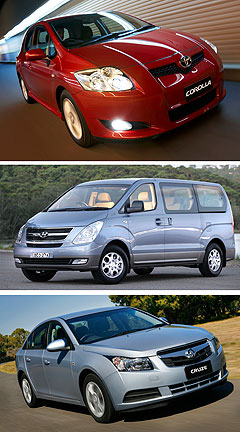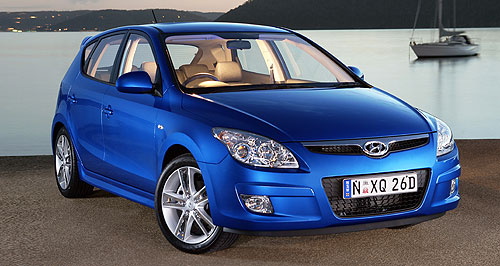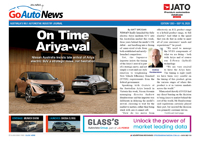Make / Model Search
News - VFACTSHyundai drives up the sales chartsRed hot: Hyundai's i30 was one of the Korean company's sales winners in July, up 118 per cent. 65 per cent sales jump propels Hyundai to fourth of July5 Aug 2009 THE rise and rise of Hyundai in the Australian car market continued in July, when sales of the Korean company’s cars leapt 65.6 per cent over the same month last year to 6226 vehicles, according to VFACTS figures released today. While the overall market slipped 10.3 per cent year-on-year to 75,333 vehicles, with most of the major car-makers and importers recording a sales deficit over July 2008, Hyundai powered up the charts on the back of strong sales of its small and light cars, light commercial vehicles and SUVs. Hyundai trailed only the three local car-makers - Toyota, Holden and Ford - as it recorded its highest monthly sales ranking, fourth, by pipping Mazda (6024). And for the second month in a row, Hyundai out-sold Ford in passenger car sales – 4715 units to 4647 – to grab third place behind Toyota and Holden. A potential industry sales hangover from an end-of-financial-year buying rush in June largely failed to materialise, with order backlogs helping to minimise the damage. However, several business fleet favourites did suffer, with the Holden Commodore (down 21.4 per cent on July 2008), the Ford Falcon (-17.7 per cent), Toyota Corolla (-13.1 per cent) and Toyota Camry (-10.2 per cent) taking a hit.  From top: Toyota Corolla, Hyundai iMax, Holden Cruze. From top: Toyota Corolla, Hyundai iMax, Holden Cruze.Light commercial vehicle sales slipped 20 per cent on July last year – and down by almost half on July’s bumper sales crop. By contrast, sales of small cars popular with private buyers powered on regardless, with the heavily advertised Mitsubishi Lancer up 56 per cent, Hyundai i30 rocketing 118 per cent and Mazda3 steady, slipping just 1.9 per cent. The Toyota Corolla was the country’s number-one seller, on 3891 units, ahead of Holden’s Commodore (3856 units), Ford Falcon (2837) and Toyota HiLux (2563). Toyota again was overall market leader with 16,664 sales – a decline of 18.8 per cent – but its July share slipped from 24.4 per cent last year to 22.1 per cent. Year to date, Toyota is holding 20.9 per cent of the market, compared with 23.6 per cent at this time last year. This year, Toyota has shed 33,207 sales, which is not far off Hyundai’s total sales for this year (36,161). Second-placed Holden suffered a sales decline of only 7.9 per cent in July, thanks largely to a solid opening performance by its new Korean-made small car, the Cruze, with 1982 units. Holden’s 10,266 sales helped it to make up ground in market share, emerging with 13.6 per cent for July – up marginally on its 13.3 per cent share last year and an improvement on its 12.5 per cent YTD. Arch rival Ford lost both volume and share, with July sales down 17.8 per cent to 7783 units, which translates to a 10.3 per cent share. In July last year, Ford’s share was 11.3 per cent. So far this year, its share sits at 10.2 per cent. Although Mazda remains entrenched in fourth place in the market YTD (8.4 per cent share), its 6024 sales in July represents eight per cent of the monthly market. Hyundai came over the top with 6226 sales for July – 65.6 per cent up on the company’s 2008 July sales tally of 3759 units, but slightly down on June’s record result (7862). Its market share almost doubled from 4.5 per cent in July 2008 to 8.3 per cent. Year to date, Hyundai sales are up 28.3 per cent, for a 6.8 per cent share. This meteoric growth has been propelled by sales increases across the range, led by the ageing Getz – the top-seller in the light car segment with 2147 sales in July (up 36.4 per cent) – and i30 small car (up 118 per cent, to 2045 units). Hyundai Australia sales and marketing director Kevin McCann said Hyundai’s July result consolidated Hyundai’s position in the Australian automotive landscape. “Our committed Hyundai dealer network is continuing to deliver exactly what today’s buyers want: award-winning products coupled with outstanding value,” he said. “Our broadening buyer profile reflects the brands acceptance as a challenger to the leading manufacturers.” Hyundai’s emergence as a light-commercial vehicle power was evident in the growth in sales of the iLoad (up 103 per cent, to 313 units) and in people-movers, with iMax up 240 per cent, to 194 units for its best-ever month. In the SUV segment, Hyunda’s Tucson jumped 153 per cent to a handy 960 units in July, while Santa Fe sales grew a comparatively modest 33 per cent to 238 units. Hyundai’s success in Australia mirrors its rise in the US where the combined sales of cars by Hyundai and its wholly-owned subsidiary Kia rose nine per cent in July. The Australian small-car market was one of the few segments to enjoy growth in July – up 2.7 per cent on the same month last year. As usual, the segment was dominated by the Toyota Corolla (3891) and Mazda3 (2785). Medium car sales were one of July’s biggest casualties – down 23.3 per cent, taking its decline for the seven months this year to 21.1 per cent. The Toyota Camry took a whopping 41 per cent of the segment in July, but with only 1717 sales, Toyota’s local hero is struggling to hold its place in Australia’s automotive top 10. The important large-car market dominated by the Commodore and Falcon suffered to the tune of 19.5 per cent, while the upper large segment – led by the Holden Caprice and Statesman – was down 45.8 per cent. Sportscar sales – spurred by the arrival of several new models from Europe – lifted 10.3 per cent in July, compared with a 10.3 per cent decline YTD. At the luxury end of the market, most brands threw off the gloom by recording handsome volume growth. Audi July sales were up 26.1 per cent, BMW up 5.0 per cent, Lexus up 18 per cent, Porsche up 31.6 per cent, Ferrari up 18.2 per cent and Alfa Romeo up 15.7 per cent. Exceptions were luxury leader Mercedes-Benz (-11.1 per cent) and Jaguar (-36.9 per cent). Caught by falling sales of its top-selling C-class (down 41 per cent in July), Mercedes sold 1429 vehicles for the month – just eight more than BMW. The sports utility vehicle (SUV) market held up its end, with July sales coming within 0.7 per cent of July sales last year, to 14,752 units. However, one of the previous market segment leaders, the Toyota LandCruiser Wagon, continued at below-2008 levels, down 35 per cent for the month and 42.5 per cent down YTD. The battle for top-selling SUV was a race in three between the compact Subaru Forester (1146 units), medium Toyota Prado (1117) and the narrow winner, Toyota Kluger (1167). Light commercial vehicle sales, which enjoyed a bumper month in June as a result of rush of orders from small businesses taking advantage of tax depreciation breaks, fell back to earth with a thud in July. Total July LCV sales totalled 12,026 units – almost half the June figure of 23,143 units – and 20 per cent lower than July 2008’s tally. Ute sales plunged almost 10,000 units, to 9970 vehicles, which was a 20 per cent fall on July 2008. The Toyota HiLux continues to hold sway, with a total of 2563 sales for the month, although that is almost 30 per cent down on the same month last year. Holden’s Ute, which gained 6.3 per cent in July sales, accounted for its rival Ford Falcon Ute, 918 to 817. Federal Chamber of Automotive Industries (FCAI) chief executive Andrew McKellar said the July sales data showed business sales remain strong. “There is evidence that there has been some flow-on from the very strong June sales result, particularly from buyers accessing the business tax break on new investments,” he said. “This has been a very successful stimulus measure and small businesses remain eligible for a 50 per cent tax break until the end of the year. “It’s also important to remember that the tax break remains in place for general businesses at a rate of 10 per cent, which is still a valuable incentive.” Mr McKellar said some brands were reporting that as a result of stronger sales in recent months they have supply constraints on certain models, again proving the success of the federal government’s tax incentive. Year-to-date 530,556 new vehicles have been sold, down 15.3 per cent (96,115) compared to the same period last year.
 Read more |
Click to shareVFACTS articlesResearch VFACTS Motor industry news |
|||||||||||||||||||||||||||||||||||||||||||||||










Facebook Twitter Instagram